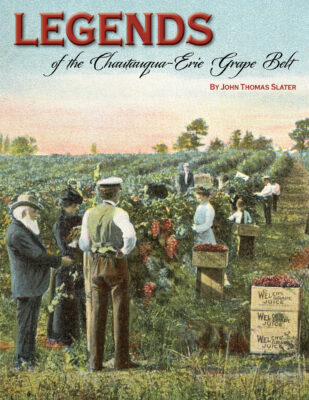
When most people think of New York wine, they think of the Finger Lakes, or maybe Long Island or the Hudson Valley. But thanks to John Thomas Slater and Douglas DeCroix’s book, an unsung region with an outsize impact on the history and future of winemaking in America—the Chautauqua-Erie Grape Belt—is finally getting its due.
“Receiving the Jim Finkle Industry Award means so much to me personally, but I feel like it’s also a long overdue honor for the region itself,” says John Thomas Slater, who shares the accolade with his editor at the magazine Western New York Heritage, Douglas DeCroix. “Doug and I, and dozens of other people worked together for more than a decade on Legends of the Chautauqua-Erie Grape Belt, and getting this prize validates the hard work. I also hope that it helps shed light on the story that we tried to tell in the book.”

The New York Wine & Grape Foundation created the Unity Awards in 1990 to celebrate, recognize and encourage cooperation among grape growers, wineries, researchers, retailers and others who contribute to the advancement of this dynamic industry.
The Jim Finkle Industry Award is intentionally broad in scope in order to recognize the outstanding achievements in aspects of the industry not directly covered by Unity and the other awards. The award is named for the late Jim Finkle, former president of the International Federation of Wines and Spirits, and later the senior vice president of external affairs at Constellation Brands.
Thomas Slater—who is in his 80s—explains that Legends of the Chautauqua-Erie Grape Belt and the award represent not just the work of an entire region over many generations, but serve as a tribute to his grandfather D.W. Thomson, family and a life filled with the love of community, history and agriculture.
“Growing up, I remember wandering the fields here with my grandfather [D.W. Thomson],” Thomas Slater recalls of the successful agricultural operation, Eastwood Farm, that Thomson managed in North East, PA. “He eventually began growing grapes for Welch’s, and he was part of the movement to turn the grape juice business into a central part of the local farm economy around Erie.”
He grew up with a profound respect for the art and science of growing things, as well as the way that the 55-mile Grape Belt that spanned Silver Creek, NY to Harborcreek, PA influenced the fate of not just the community that surrounded it, but the culture of wine writ large.
“I grew up, moved away and worked in corporate America for many decades, but when my grandfather died in 1979, and then again when I retired in 1992, I felt a desire to share the story of the region,” Thomas Slater explains of his inspiration.
He returned to the region in 1992, but it wasn’t until the early aughts that he felt he had the time and resources to devote to a deep dive. Little did he know just how deep and wide that dive would be.
“I started out by contacting every government historian in Chautauqua county,” Thomas Slater confesses, adding that once historians understood that he wanted to tell the untold story of the region’s contribution to agriculture and viticulture, they opened their files to him. “Eventually, we formed a study group of people who were sharing old family documents they’d had in their attic for years.”
What started out as a linear history was transformed into a multimedia project that brought together thousands of previously unseen documents, photographs and histories. After a decade of research, Thomas Slater produced not only the book, but also an archive that he donated to the Darwin R. Barker Historical Museum in Fredonia.
 The book itself breaks down what Thomas Slater and his very patient editor Decroix identified as the Five Epochs defining the region.
The book itself breaks down what Thomas Slater and his very patient editor Decroix identified as the Five Epochs defining the region.
The first shares an overview of the grape’s arrival via European settlers, including portraits of key figures like Deacon Elijah Fay, often dubbed the “Father” of the Chautauqua-Erie grape industry, who planted Isabella and Catawba grapes there in 1824.
The second highlights the region’s early reputation as a leading wine appellation.he third gets into Chautauqua-Erie’s transition to growing table grapes in the mid-to-late 1800s when it was the largest table-grape growing region in the world. It also covers its eventual fall amid the advent of efficient cross-country rail traffic.
Epoch four outlines the rise of grape farming for juice in the belt, and the growth of an industry and infrastructure to support it through the mid-20th century until competition abroad essentially squelched it.
Epoch five is focuses on the reset and resurgence the Chautauqua-Erie region is currently witnessing. It also highlights the incredible scientific and mechanical innovations born there, from mechanical harvesting technology to revolutionary vine-training systems (most notably the Geneva Double Curtain).
As with all things wine, what’s old is new again in Chautauqua-Erie, and the region is producing some of the state’s most interesting and innovative wines.

